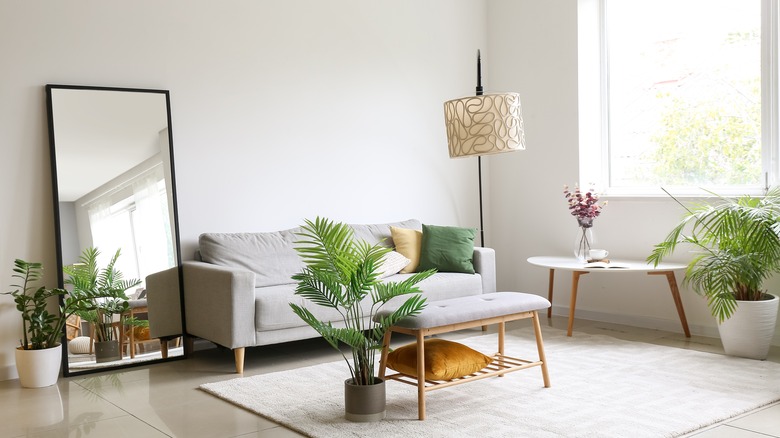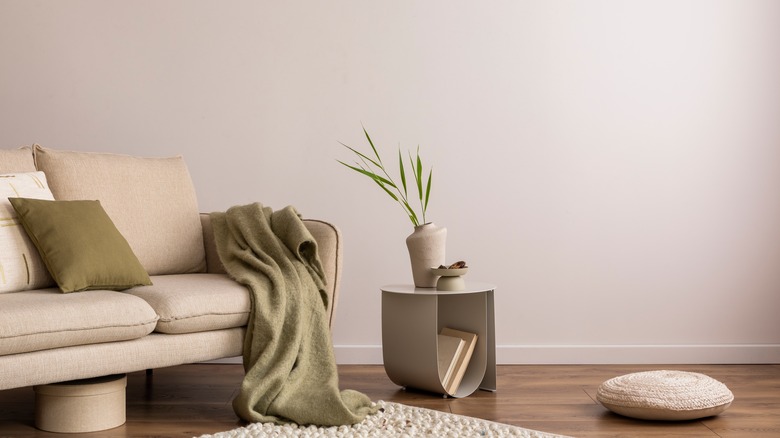100 Day Dream Home On The Best Way To Add Color To A White Home
White isn't going out of style any time soon. This timeless neutral is sure to adorn kitchen cabinets and interior walls for years to come. However, decorating with white can be tricky, and it often requires a balancing act. Too much white can often feel cold, austere, and boring. However, if you're not one for filling your space with color, you might be cautious about adding an additional shade. As was the case on a Season 4 episode of HGTV's "100 Day Dream Home," where the couple, Kristin and Jason, differed on how much white should be in their new home. While Jason was happy with an all-white and mostly neutral interior, Kristin felt like their future home needed more color and warmth to make it cozy. Luckily, with white being neutral, it pairs well with nearly any shade.
Co-host and designer Mika Kleinschmidt had a brilliant compromise: a wood tone on the kitchen island. "Any time you go with a natural material, it normally will warm yours [your home] up a little bit," Kleinschmidt told the couple (via HGTV). "A lot of times, clients are not willing to take the risk with bold colors. I normally recommend incorporating just a hint of either wood or some organic elements, so the house still feels warm, inviting, and cozy." Wood tones can help break up a swarth of white and add a natural warmth without bringing in colors that may feel too bold in the space.
Add in organic elements
While Mika Kleinschimdt's clients opted for a wood finish on the island in the kitchen, the material is easily used throughout the home and doesn't always have to be a permanent fixture like cabinets. Wood furniture, such as coffee tables, side chairs, and hutches, is a great way to infuse that natural warmth into your home. Outside of wood, other organic materials can also help break up an all-white interior by adding some texture.
Wood-like textures like rattan and wicker, as well as stone, clay, and ceramic, can all add an organic touch without disturbing a neutral color palette. Consider rattan and wicker furniture or smaller decorative details, such as baskets or light fixtures. Stone, clay, and ceramic can all work for decorative objects such as vases, trays, and lighting fixtures. When it comes to fabrics, organic materials like cotton and linen are the best to incorporate for pillows, blankets, rugs, and soft furniture pieces. Plants and foliage are other organic details you can add to liven up an all-white space. Consider plants like eucalyptus, olive trees, and ficus varieties to add color and texture to a room.
Expanding the color palette
Natural materials are a great way to add warmth and make an all-white color palette feel more inviting. However, you can also take cues from these materials to expand the color palette beyond white. Warmer shades of neutrals, such as creams and beiges, are a great way to maintain an understated neutral color scheme while also adding a coziness that stark white lacks. With a neutral base, you can feel confident adding small instances of color. When it comes to actual colors, again, take your inspiration from nature. Warm earth-toned reds, yellows, blues, and greens can prevent a space from looking like an undefined sea of white. Brass and gold finishes add a metallic element and sleek texture that can add unique details.
When the majority of the room is white, being strategic about accent color placement will help create a harmonious design. Be cautious about balancing larger feature details like accent walls, painted built-in bookcases, and furniture with smaller instances of color like pillows, art, and area rugs. Too many of these elements can overwhelm a room. With the presence of a main feature color, keep smaller accents to a minimum so as not to overrun the room.

